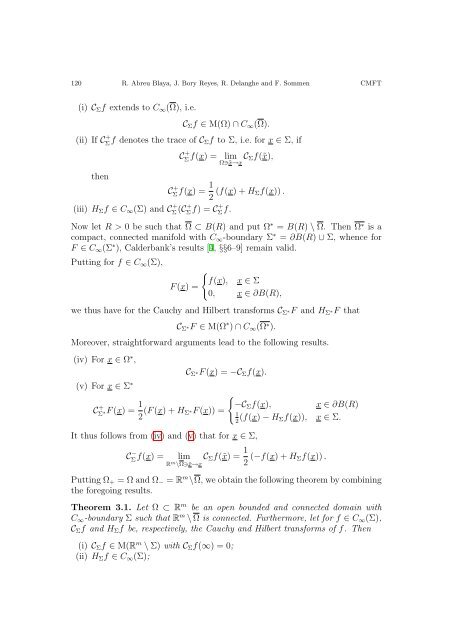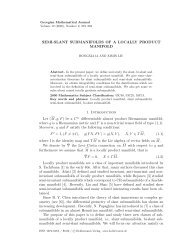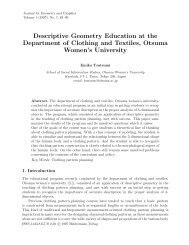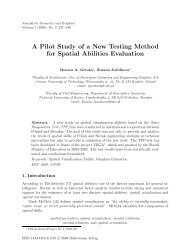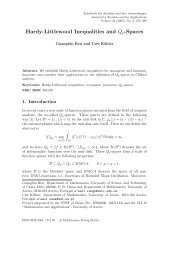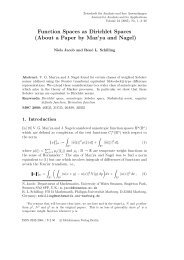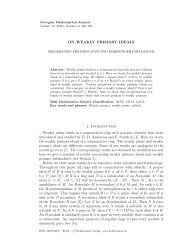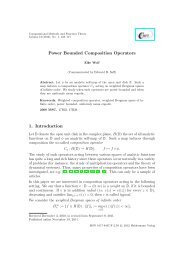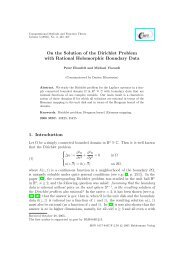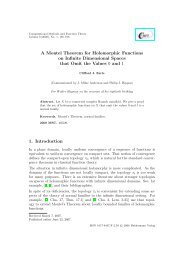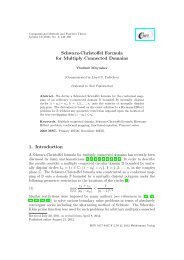Cauchy Integral Decomposition of Multi-Vector Valued Functions on ...
Cauchy Integral Decomposition of Multi-Vector Valued Functions on ...
Cauchy Integral Decomposition of Multi-Vector Valued Functions on ...
You also want an ePaper? Increase the reach of your titles
YUMPU automatically turns print PDFs into web optimized ePapers that Google loves.
120 R. Abreu Blaya, J. Bory Reyes, R. Delanghe and F. Sommen CMFT<br />
(i) C Σ f extends to C ∞ (Ω), i.e.<br />
C Σ f ∈ M(Ω) ∩ C ∞ (Ω).<br />
(ii) If C + Σ f denotes the trace <str<strong>on</strong>g>of</str<strong>on</strong>g> C Σf to Σ, i.e. for x ∈ Σ, if<br />
then<br />
C + Σ f(x) =<br />
lim C Σf(˜x),<br />
Ω∋˜x→x<br />
C + Σ f(x) = 1 2 (f(x) + H Σf(x)) .<br />
(iii) H Σ f ∈ C ∞ (Σ) and C + Σ (C+ Σ f) = C+ Σ f.<br />
Now let R > 0 be such that Ω ⊂ B(R) and put Ω ∗ = B(R) \ Ω. Then Ω ∗ is a<br />
compact, c<strong>on</strong>nected manifold with C ∞ -boundary Σ ∗ = ∂B(R) ∪ Σ, whence for<br />
F ∈ C ∞ (Σ ∗ ), Calderbank’s results [4, §§6–9] remain valid.<br />
Putting for f ∈ C ∞ (Σ),<br />
{<br />
f(x), x ∈ Σ<br />
F (x) =<br />
0, x ∈ ∂B(R),<br />
we thus have for the <str<strong>on</strong>g>Cauchy</str<strong>on</strong>g> and Hilbert transforms C Σ ∗F and H Σ ∗F that<br />
C Σ ∗F ∈ M(Ω ∗ ) ∩ C ∞ (Ω ∗ ).<br />
Moreover, straightforward arguments lead to the following results.<br />
(iv) For x ∈ Ω ∗ ,<br />
(v) For x ∈ Σ ∗<br />
C Σ ∗F (x) = −C Σ f(x).<br />
{<br />
C + Σ ∗F (x) = 1 2 (F (x) + H Σ ∗F (x)) = −C Σ f(x), x ∈ ∂B(R)<br />
1<br />
(f(x) − H 2 Σf(x)), x ∈ Σ.<br />
It thus follows from (iv) and (v) that for x ∈ Σ,<br />
C − Σ f(x) =<br />
lim C Σ f(˜x) = 1<br />
R m \Ω∋˜x→x 2 (−f(x) + H Σf(x)) .<br />
Putting Ω + = Ω and Ω − = R m \Ω, we obtain the following theorem by combining<br />
the foregoing results.<br />
Theorem 3.1. Let Ω ⊂ R m be an open bounded and c<strong>on</strong>nected domain with<br />
C ∞ -boundary Σ such that R m \ Ω is c<strong>on</strong>nected. Furthermore, let for f ∈ C ∞ (Σ),<br />
C Σ f and H Σ f be, respectively, the <str<strong>on</strong>g>Cauchy</str<strong>on</strong>g> and Hilbert transforms <str<strong>on</strong>g>of</str<strong>on</strong>g> f. Then<br />
(i) C Σ f ∈ M(R m \ Σ) with C Σ f(∞) = 0;<br />
(ii) H Σ f ∈ C ∞ (Σ);


